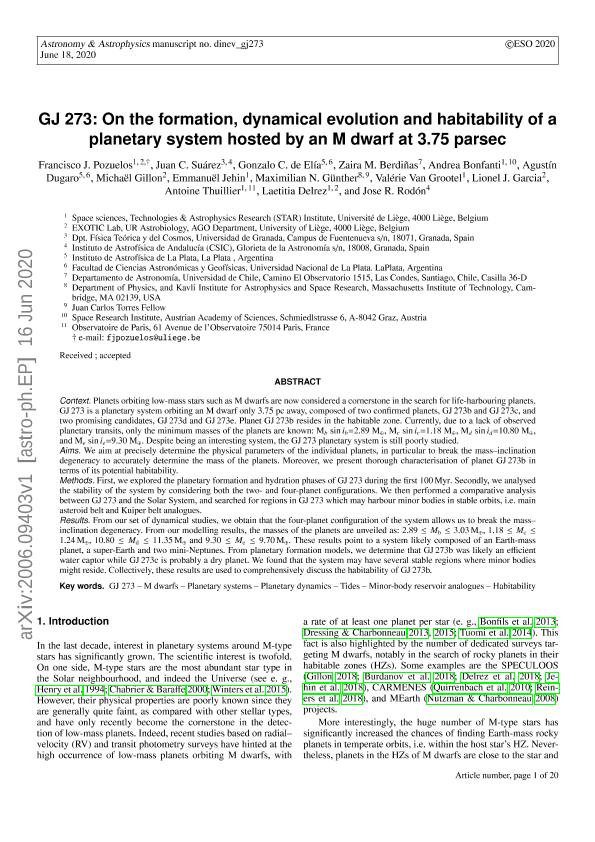Mostrar el registro sencillo del ítem
dc.contributor.author
Pozuelos, F. J.
dc.contributor.author
Suárez, J. C.
dc.contributor.author
de Elía, G. C.
dc.contributor.author
Berdiñas, Z.
dc.contributor.author
Bonfanti, A.
dc.contributor.author
Dugaro, Agustin

dc.contributor.author
Guillon, M.
dc.contributor.author
Jehin, E.
dc.contributor.author
Mantilla Alarcon, Gunther Alfredo

dc.contributor.author
Abad Santos, Natalia Vanesa

dc.contributor.author
Garcia, Lorena Claudia

dc.contributor.author
Thuillier, A.
dc.contributor.author
Delrez, L.
dc.contributor.author
Rodón, Julieta Stefanía

dc.date.available
2021-11-03T17:16:19Z
dc.date.issued
2020-09
dc.identifier.citation
Pozuelos, F. J.; Suárez, J. C.; de Elía, G. C.; Berdiñas, Z.; Bonfanti, A.; et al.; GJ 273: On the formation, dynamical evolution, and habitability of a planetary system hosted by an M dwarf at 3.75 parsec; EDP Sciences; Astronomy and Astrophysics; 641; A23; 9-2020; 1-19
dc.identifier.issn
0004-6361
dc.identifier.uri
http://hdl.handle.net/11336/145851
dc.description.abstract
Context. Planets orbiting low-mass stars such as M dwarfs are now considered a cornerstone in the search for planets with thepotential to harbour life. GJ 273 is a planetary system orbiting an M dwarf only 3.75 pc away, which is composed of two confirmedplanets, GJ 273b and GJ 273c, and two promising candidates, GJ 273d and GJ 273e. Planet GJ 273b resides in the habitable zone.Currently, due to a lack of observed planetary transits, only the minimum masses of the planets are known: Mb sin ib=2.89 M⊕ ,Mc sin ic =1.18 M⊕, Md sin id =10.80 M⊕ , and Me sin ie =9.30 M⊕ . Despite its interesting character, the GJ 273 planetary system hasbeen poorly studied thus far.Aims. We aim to precisely determine the physical parameters of the individual planets, in particular, to break the mass?inclinationdegeneracy to accurately determine the mass of the planets. Moreover, we present a thorough characterisation of planet GJ 273b interms of its potential habitability.Methods. First, we explored the planetary formation and hydration phases of GJ 273 during the first 100 Myr. Secondly, we analysedthe stability of the system by considering both the two- and four-planet configurations. We then performed a comparative analysisbetween GJ 273 and the Solar System and we searched for regions in GJ 273 which may harbour minor bodies in stable orbits, that is,the main asteroid belt and Kuiper belt analogues.Results. From our set of dynamical studies, we find that the four-planet configuration of the system allows us to break the mass?inclination degeneracy. From our modelling results, the masses of the planets are unveiled as: 2.89 ≤ Mb ≤ 3.03 M⊕ , 1.18 ≤ Mc ≤1.24 M⊕ , 10.80 ≤ Md ≤ 11.35 M⊕ , and 9.30 ≤ Me ≤ 9.70 M⊕. These results point to a system that is likely to be composed of anEarth-mass planet, a super-Earth and two mini-Neptunes. Based on planetary formation models, we determine that GJ 273b is likelyan efficient water captor while GJ 273c is probably a dry planet. We find that the system may have several stable regions where minorbodies might reside. Collectively, these results are used to offer a comprehensive discussion about the habitability of GJ 273b.
dc.format
application/pdf
dc.language.iso
eng
dc.publisher
EDP Sciences

dc.rights
info:eu-repo/semantics/openAccess
dc.rights.uri
https://creativecommons.org/licenses/by-nc-sa/2.5/ar/
dc.subject
PLANETS AND SATELLITES: DYNAMICAL EVOLUTION AND STABILITY
dc.subject
PLANETS AND SATELLITES: FORMATION
dc.subject.classification
Astronomía

dc.subject.classification
Ciencias Físicas

dc.subject.classification
CIENCIAS NATURALES Y EXACTAS

dc.title
GJ 273: On the formation, dynamical evolution, and habitability of a planetary system hosted by an M dwarf at 3.75 parsec
dc.type
info:eu-repo/semantics/article
dc.type
info:ar-repo/semantics/artículo
dc.type
info:eu-repo/semantics/publishedVersion
dc.date.updated
2021-07-01T14:23:53Z
dc.journal.volume
641
dc.journal.number
A23
dc.journal.pagination
1-19
dc.journal.pais
Francia

dc.journal.ciudad
Paris
dc.description.fil
Fil: Pozuelos, F. J.. Université de Liège; Bélgica
dc.description.fil
Fil: Suárez, J. C.. Universidad de Granada; España
dc.description.fil
Fil: de Elía, G. C.. Consejo Nacional de Investigaciones Científicas y Técnicas. Centro Científico Tecnológico Conicet - La Plata. Instituto de Astrofísica La Plata. Universidad Nacional de La Plata. Facultad de Ciencias Astronómicas y Geofísicas. Instituto de Astrofísica La Plata; Argentina. Conicet - Instituto de Astrofisica La Plata - UNLP; Argentina
dc.description.fil
Fil: Berdiñas, Z.. Universidad de Chile; Chile
dc.description.fil
Fil: Bonfanti, A.. Université de Liège; Bélgica
dc.description.fil
Fil: Dugaro, Agustin. Consejo Nacional de Investigaciones Científicas y Técnicas. Centro Científico Tecnológico Conicet - La Plata. Instituto de Astrofísica La Plata. Universidad Nacional de La Plata. Facultad de Ciencias Astronómicas y Geofísicas. Instituto de Astrofísica La Plata; Argentina
dc.description.fil
Fil: Guillon, M.. Université de Liège; Bélgica
dc.description.fil
Fil: Jehin, E.. Université de Liège; Bélgica
dc.description.fil
Fil: Mantilla Alarcon, Gunther Alfredo. Massachusetts Institute Of Technology; Estados Unidos
dc.description.fil
Fil: Abad Santos, Natalia Vanesa. Université de Liège; Bélgica
dc.description.fil
Fil: Garcia, Lorena Claudia. Université de Liège; Bélgica
dc.description.fil
Fil: Thuillier, A.. Université de Liège; Bélgica
dc.description.fil
Fil: Delrez, L.. Université de Liège; Bélgica
dc.description.fil
Fil: Rodón, Julieta Stefanía. Instituto de Astrofísica de Andalucía; España
dc.journal.title
Astronomy and Astrophysics

dc.relation.alternativeid
info:eu-repo/semantics/altIdentifier/doi/http://dx.doi.org/10.1051/0004-6361/202038047
dc.relation.alternativeid
info:eu-repo/semantics/altIdentifier/url/https://arxiv.org/abs/2006.09403
Archivos asociados
